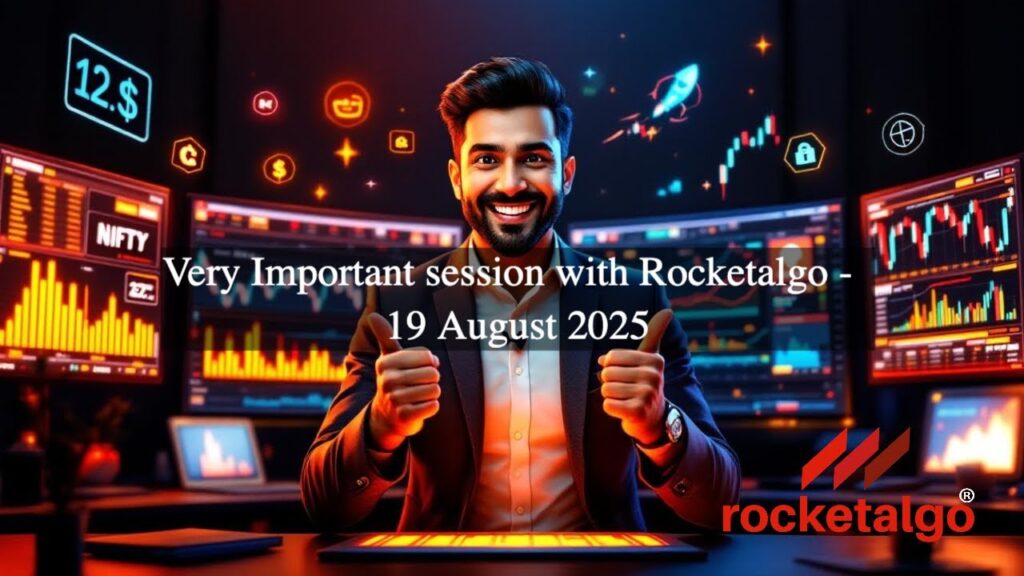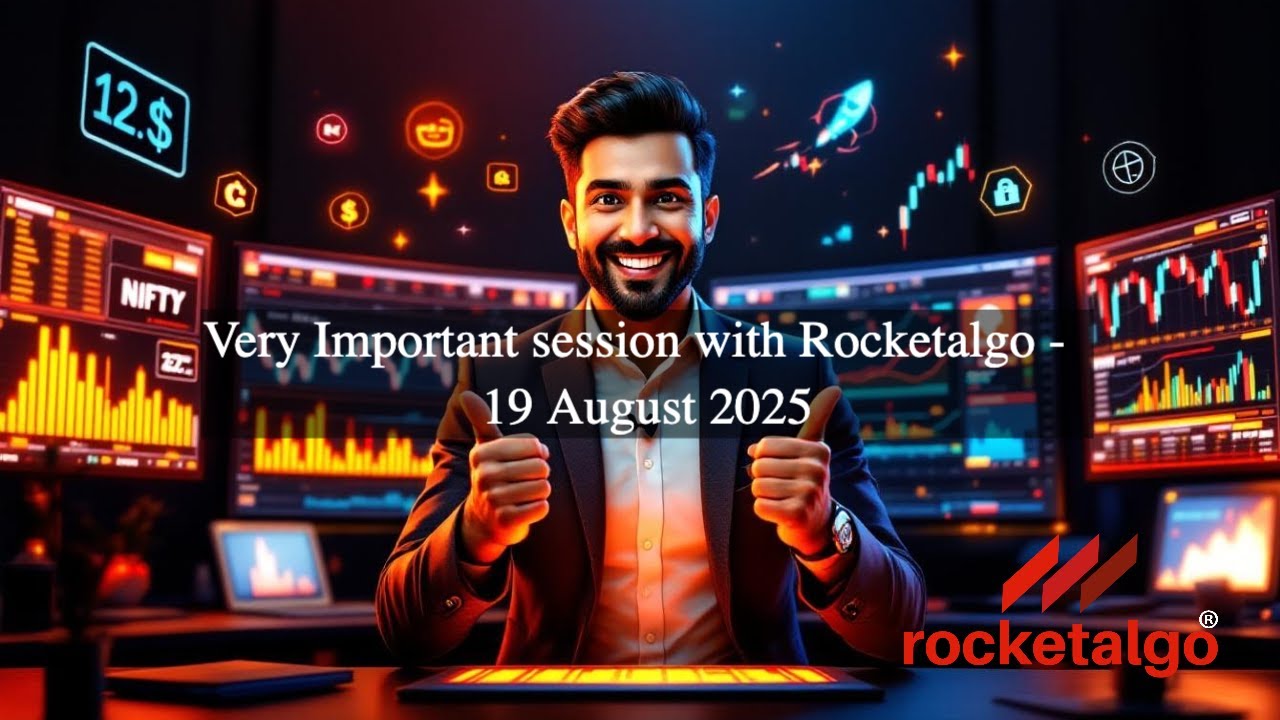
In this in-depth article I recap a high-value session I presented for Rocketalgo Official and translate the ideas into a practical guide you can use right now. The session focused on discipline, focus, and practical rules for anyone trading in the trading, stock market, NSE, BSE, Nifty environment. If you follow our work you already know the tone: direct, no-nonsense, and full of real-world examples. In the next 2,000+ words I’ll explain exactly what I said, why it matters, and how to make it actionable in your own trading, stock market, NSE, BSE, Nifty routine.
Table of Contents
- 🧭 Why this session matters: get out of the “gut-feeling” trap
- 💡 Focus beats fuzz: stop being a jack of all trades
- 📈 A strategy that actually works (and why switching weekly won’t)
- 🖼️ Screenshots and live alerts: reading market signs correctly
- ⚙️ How to build a focused practice routine
- 🔁 The cost of switching markets without mastery
- 🛡️ Use rules not feelings: trade like a professional
- ⏱️ Speed and risk: the Ferrari and bike analogy
- 🔔 Systems, subscriptions and why support matters
- 🧠 Know your teacher: experience beats hype
- 📉 Common mistakes I repeatedly see (and how to stop them)
- 📊 Case study: a trade that followed the rules
- 🧾 Practical checklist you can implement tomorrow
- 🧩 How Rocketalgo tools help (and why you still need discipline)
- ❓ Frequently Asked Questions (FAQ) ✅
- 🧭 Final takeaways — trade smarter, not harder
- 📣 Final resources and next steps
🧭 Why this session matters: get out of the “gut-feeling” trap
One line I repeated often was blunt: “Your gut feelings are costing you money.” I meant it. In trading, stock market, NSE, BSE, Nifty contexts, decisions shouldn’t be driven by inner hunches. Markets move because of price action, liquidity, news, participants and technical context — not because someone felt it in their bones.

When people say “I had a feeling”, what usually follows is regret. I demonstrated the idea with real examples during the session: trades that looked safe in the moment but were held past clear exit signs. A late entry plus emotional holding can erase an otherwise healthy trade. The remedy? Rules, setups, and repeatable practice.
💡 Focus beats fuzz: stop being a jack of all trades
One of the strongest messages: stop trying to do everything. You cannot master everything at once. If you’re splitting time between Nifty, Bank Nifty, midcaps, crude, gold, bitcoin, FOREX and more, your edge will be watered down. I said: ‘Jack of all trades, master of none’ — and it’s true for trading, stock market, NSE, BSE, Nifty work. Pick your arena and grind it.
The analogy I used was simple: a general store sells everything and gets occasional customers, while a specialty shop focuses on a specific product and builds reputation and expertise. Trading is no different: specializing increases repeatable success. Practice the same setup hundreds or thousands of times until it becomes reflexive.
📈 A strategy that actually works (and why switching weekly won’t)
Every week there’s a new “strategy” floating on social media. One week it’s 72 candlestick patterns, the next week some obscure oscillator. My message: stop chasing the next shiny strategy and instead perfect one reliable approach for your market. If you try to learn 72 candlestick patterns and apply them all at once, you will fail to build a consistent edge. Practice one core strategy until execution is exact and rhythm-based.
Consistency is the multiplier: doing one good thing well hundreds of times beats doing many things badly. In a trading, stock market, NSE, BSE, Nifty environment, edge comes from repeatable setups, defined risk, and disciplined exits.
🖼️ Screenshots and live alerts: reading market signs correctly
During the session I walked through live examples, showing how our Rocketalgo alerts and price-watch signals warn of resistance and profit-booking zones. One practical example was a trade with a clear entry, followed by a visible resistance level and a timer indicating a likely reversal. The system highlighted when to book profit — and yet users sometimes hold out of hope. That hope is often costly.
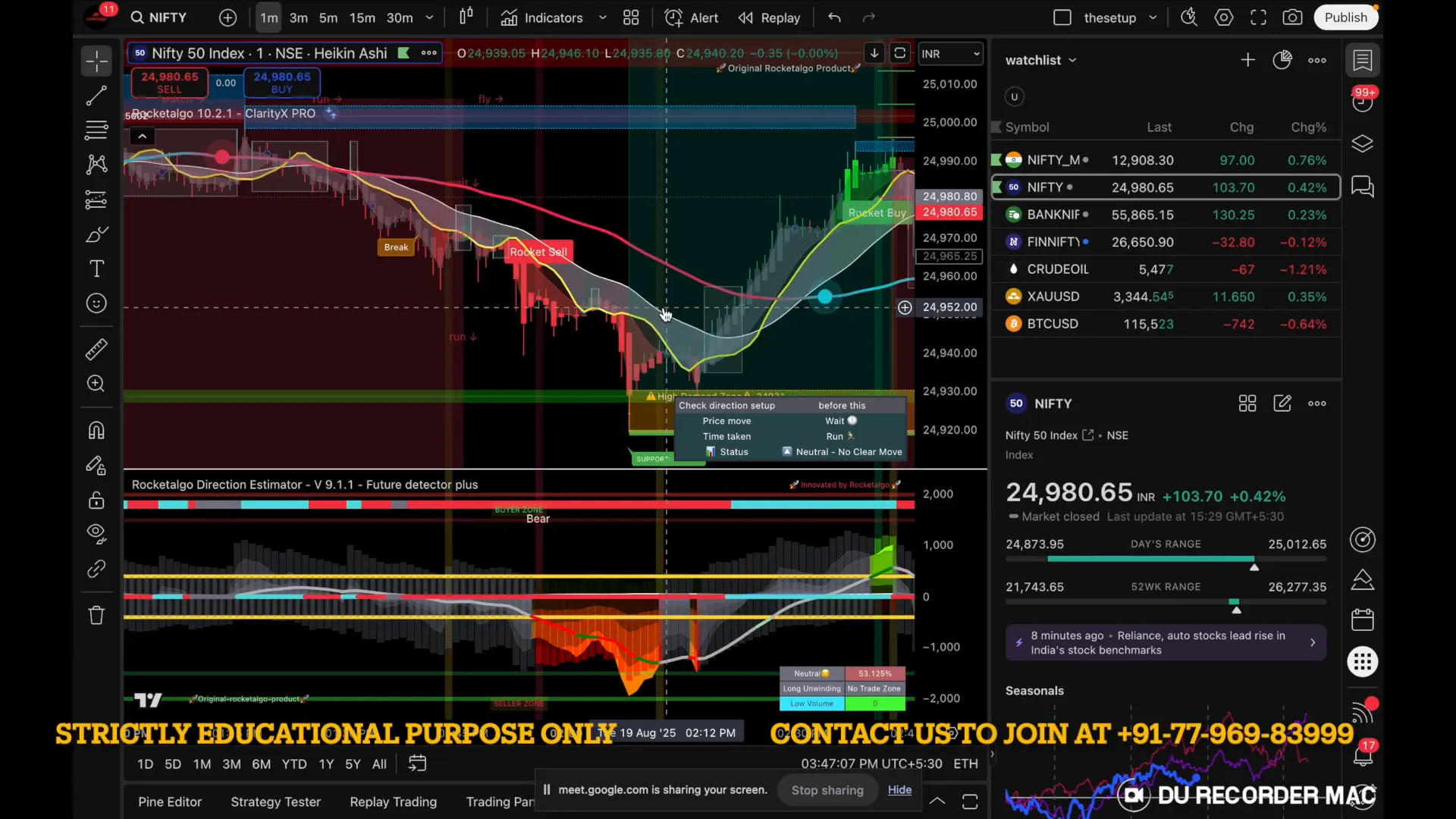
When the system signals a resistance and then switches color to indicate profit booking or exit mode, holding is not courage — it’s gambling. If an alert signals exit and price confirms a resistance, book your profit. The alternative is emotional holding which can flip small wins into losses quickly.
⚙️ How to build a focused practice routine
Here’s a step-by-step routine I recommended in the session for traders who want to get serious about the trading, stock market, NSE, BSE, Nifty world:
- Choose one instrument to master (e.g., Nifty or Bank Nifty).
- Choose one timeframe for your primary strategy (intraday 1-5 min, or positional daily), and stick to it.
- Define a clear setup: entry, stop-loss, target, and rules for trading during news events or volatility spikes.
- Backtest the setup and then forward-test on paper or small capital until you reach repeatable results.
- Log every trade: entry, exit, reasoning, and outcome. Learn from patterns in your log.
Repeat the same setup thousands of times. I used the Bruce Lee analogy: one kick practiced ten thousand times beats a thousand different kicks practiced once. That’s the path to an edge in trading, stock market, NSE, BSE, Nifty activities.
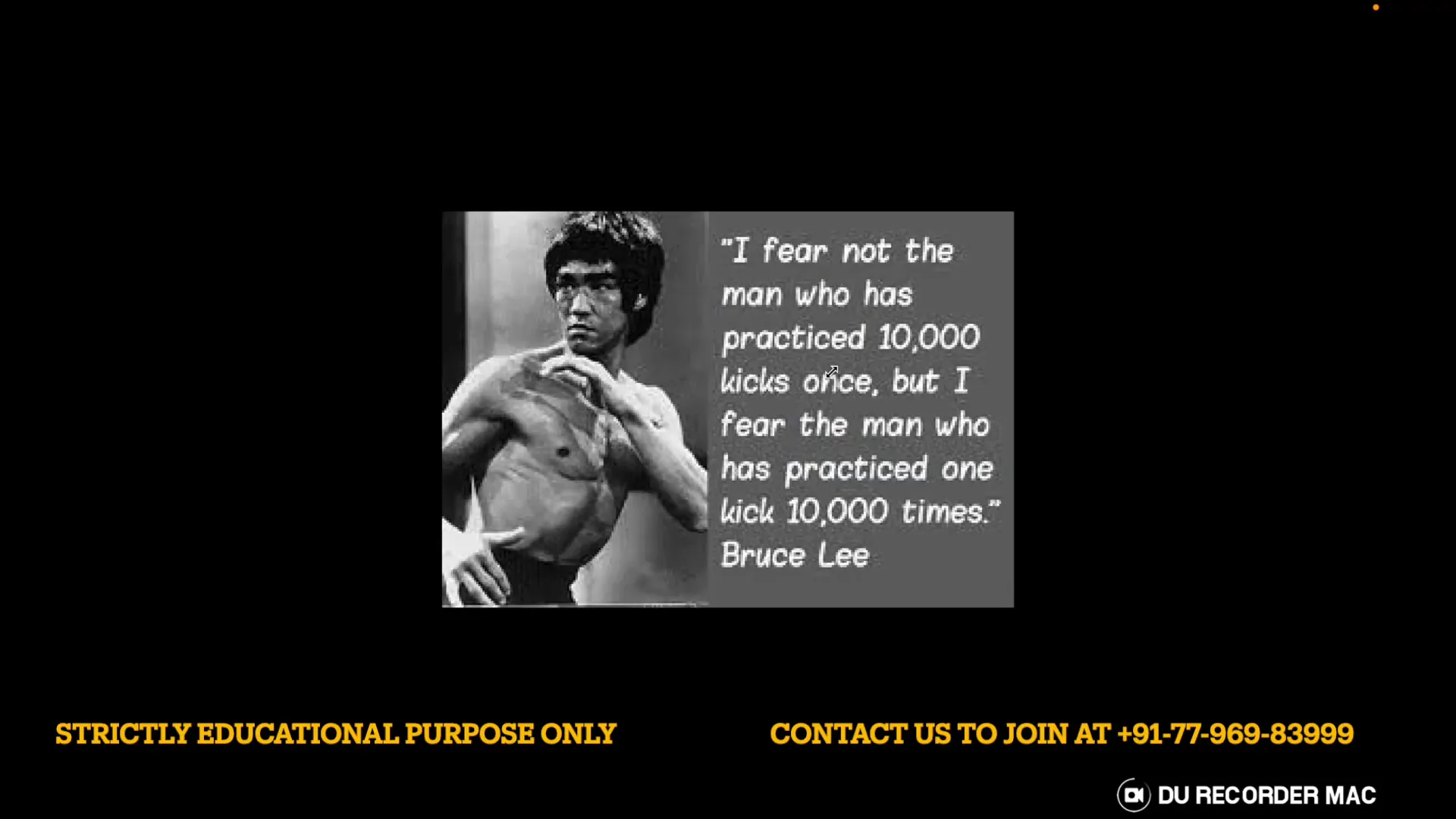
🔁 The cost of switching markets without mastery
I gave a strong example: if you’re a master of Forex pair XUUSD, you can move to another market temporarily and still rely on your core skills. But jumping between many instruments without mastery creates inconsistent outcomes. Stick to a market long enough to build pattern recognition and a feel for volatility, slippage, and order flow in that market.
When you repeatedly switch, you never internalize the micro-structure: where the stops cluster, which times see spikes, which levels attract institutional activity. Mastery requires focus.
🛡️ Use rules not feelings: trade like a professional
Professional trading is system-driven. I asked a simple question: why would you hold when the system changes its signal from buy to exit? The system doesn’t care about your ego. A late entry plus emotional refusal to cut losses leads to persistent small losses that compound — not growth. You must build an operational checklist that overrides gut feelings:
- If alert color changes to exit, close position unless pre-specified rules state otherwise.
- Use defined risk per trade (e.g., 1-2% of capital).
- Set pre-defined profit-taking levels and stick to them unless the system shows strong confirmation.
- Keep a trade log to remove emotion from post-trade analysis.
⏱️ Speed and risk: the Ferrari and bike analogy
My Ferrari/bike example is blunt: instruments that move very quickly can generate huge profits fast — but they can also destroy accounts quickly if not controlled. If a trade can triple your money in 10 minutes, it can also wipe out your position in the same speed. That’s why speed demands stronger discipline: tighter stops, smaller position sizes, and strict exit rules.
Remember: leverage magnifies both gains and losses. If you’re trading fast-moving assets, reduce capital exposure and be clinical about stop-loss placement. Control equals survival.
🔔 Systems, subscriptions and why support matters
Another practical point I emphasized: systems backed by live support and subscription-based development tend to react faster to issues. We had a minor alert-bot problem and resolved it within twenty minutes because our developers actively maintain the service. A one-time purchased “lifetime” indicator often leaves you stranded when it breaks.
When choosing tools for your trading, stock market, NSE, BSE, Nifty routine, consider whether the provider actively supports users, updates code for market changes, and offers practical customer service. A maintained service can save you money during critical moments.
🧠 Know your teacher: experience beats hype
Trading education is widespread. But not every instructor or tip caller is qualified. I gave a real-world metaphor: would you choose a well-qualified doctor over a roadside herbalist if your health depended on it? For trading, prefer teachers and services with verifiable results, a consistent track record, and transparent processes. Avoid those who sell hype and unrealistic promises.
Ask these questions before you join any course or buy a system:
- Can they show live, time-stamped proof of trades?
- Do they provide a clear methodology and explain edge and risk management?
- Is there ongoing support and updates after purchase?
📉 Common mistakes I repeatedly see (and how to stop them)
In the session I highlighted recurring mistakes traders make. Here are those mistakes and short solutions:
- Mistake: Relying on gut feelings. Fix: Follow rule-based systems and predefined exits.
- Mistake: Over-diversifying learning across too many instruments. Fix: Pick one market and one setup for months.
- Mistake: Ignoring data sources and using delayed feeds (e.g., index data with 15-min delay). Fix: Verify real-time data requirements and upgrade feeds if you trade time-sensitive instruments.
- Mistake: Chasing fast money and ignoring position sizing. Fix: Use smaller position sizes for high-volatility trades and manage risk strictly.
- Mistake: Choosing tools without support. Fix: Prefer subscription models or vendors with immediate issue resolution.
📊 Case study: a trade that followed the rules
I showcased a live trade that matched our setup: clear entry, bounce, breakout angle, then a moment of resistance and profit-booking. The system indicated the resistance and a timer counting down, so the signal was actionable — book and move on. Many traders, however, asked “should I hold?” and then regretted it. Discipline beats hesitation every time in trading, stock market, NSE, BSE, Nifty environments.
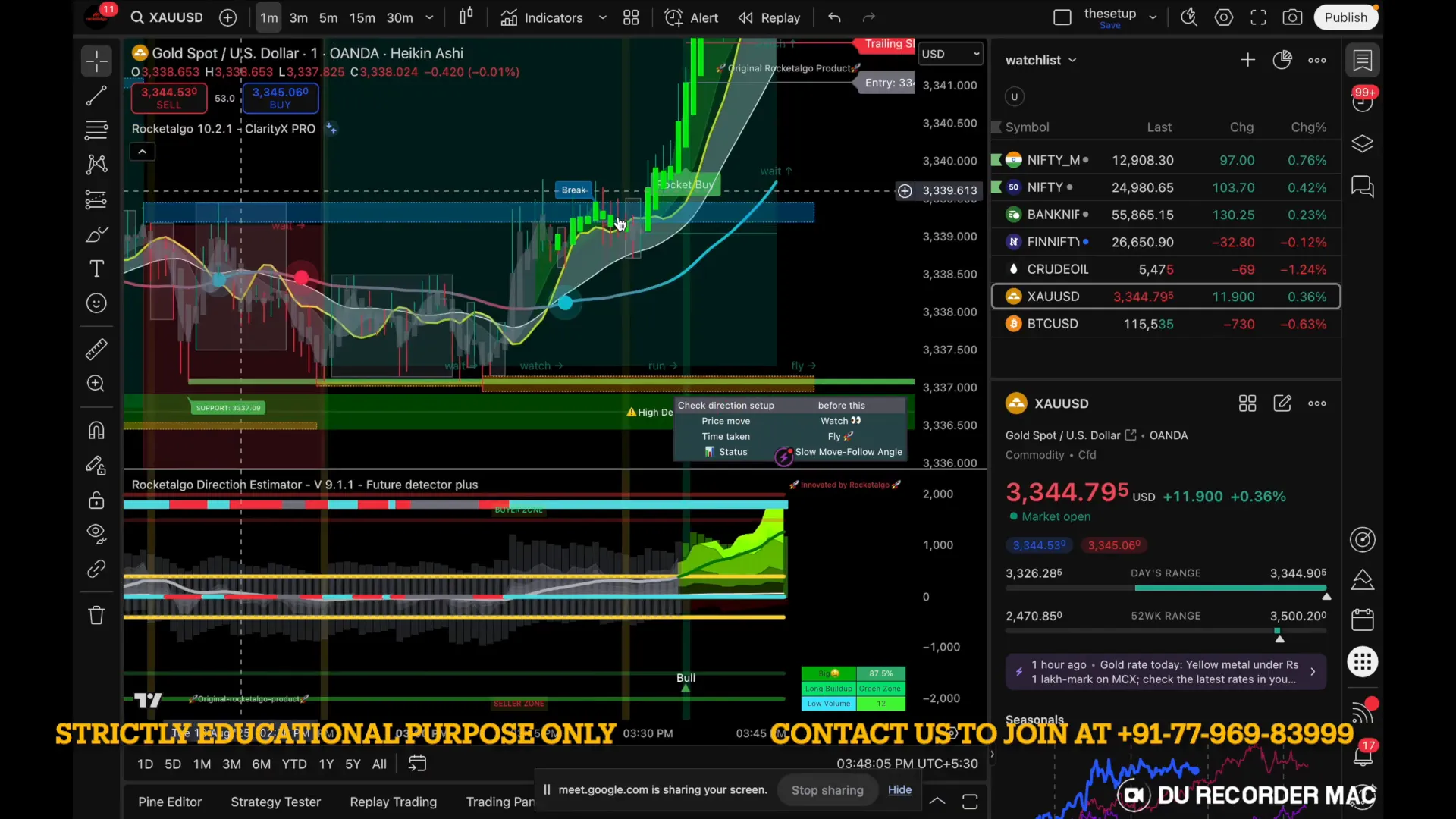
When the setup triggered and the market showed resistance, booking profit was the right call. Not because it’s always optimal, but because the pre-defined rule said so and probability favored consolidation or pullback. That’s how edge is preserved over many trades.
🧾 Practical checklist you can implement tomorrow
Before you place any trade tomorrow, run through this quick checklist derived from the session:
- Have I chosen the right market to focus on (one primary instrument)?
- Is my data real-time and reliable for the chosen instrument?
- Is my risk per trade defined and acceptable?
- Is there a clear entry, stop, and exit defined for this trade?
- If an alert changes color, do I have the discipline to follow the new instruction?
Check all five items. If any is unanswered, either delay the trade or reduce size until you fix the gap. Over time this checklist will convert theory into habit.
🧩 How Rocketalgo tools help (and why you still need discipline)
Tools and alerts can save time and surface meaningful data, but they do not remove personal responsibility. During the session I showed how alerts indicate resistance and potential exit. That reduces guesswork — but it does not eliminate the need for discipline. Use alerts to inform behavior, not justify indecision.
If you want to build long-term success in trading, stock market, NSE, BSE, Nifty contexts, tools are an accelerant — not a substitute — for discipline and repetition.
❓ Frequently Asked Questions (FAQ) ✅
Q: Should I trade multiple markets to diversify risk?
A: Not until you master one market and one setup. Trading different markets without mastery increases error. Focus on one instrument in the trading, stock market, NSE, BSE, Nifty world and build an edge there before diversifying.
Q: How important is real-time data?
A: Critical. Some platforms show delayed index data (e.g., 15 minutes) which can mislead intraday trades. If your strategy is time-sensitive, invest in a real-time data feed and ensure your broker/streaming service fits the chosen market.
Q: What’s the right leverage for intraday volatile trades?
A: Use smaller sizes. The faster the instrument, the smaller the position size relative to capital. Protect your capital first — survival is the first rule of trading.
Q: Can alerts or bots replace my decision-making?
A: No. Alerts provide signals, but you need predefined rules to act on them. Automations help with timing and discipline, but human oversight and a tested strategy are required.
Q: How many strategies should I learn?
A: Learn one thoroughly. Practice it until it produces repeatable outcomes. Then you can consider adding a second strategy. Quantity without depth rarely helps in trading, stock market, NSE, BSE, Nifty arenas.
🧭 Final takeaways — trade smarter, not harder
To close, I’ll restate the core points from the session in plain language:
- Your gut feelings will cost you money unless they are backed by a repeatable setup and rules.
- Specialize: pick one market and one timeframe and practice until it becomes second nature.
- Protect capital: define risk, use stops, and size trades appropriately.
- Use tools, alerts, and supported services — but never hand over discipline to a tool.
- Choose qualified teachers and providers, and prefer systems with active support.
Trading success in the trading, stock market, NSE, BSE, Nifty space is not about luck. It’s about process, repetition, and honesty with yourself. Follow a single verified process, do the hard work of practice, and let measured rules replace your gut feelings. That’s how small wins compound into consistent returns.
📣 Final resources and next steps
If you want to implement the ideas from this session:
- Pick your primary market this week and write a one-page plan for it.
- Create a trade checklist from the checklist section and tape it by your trading desk.
- Backtest and forward-test one setup for at least 90 days before expanding.
- Choose data and tools with active support — and verify with time-stamped trade evidence.
If you apply these principles, your path in trading, stock market, NSE, BSE, Nifty activities becomes clearer: fewer mistakes, more repeatable wins, and less emotional dragging of good trades into losses.
Thank you for reading. If you found this article helpful, keep practicing the fundamentals — one setup, one market, one thousand repetitions.
Need more help |
|
Contact us by clicking the button below |
|
Click me |

